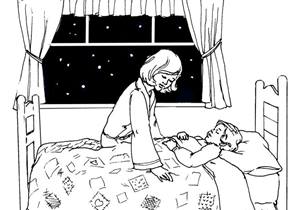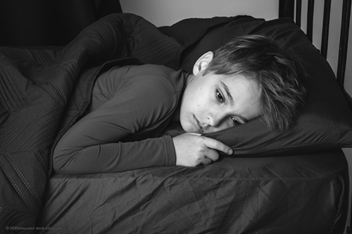Sleep Terrors and Sleepwalking

Sleep terrors and sleepwalking are related disorders of sleep that usually go away by the teen years. They typically occur within 1 to 2 hours after the child has fallen asleep. The sleep terror or sleepwalking may last a few minutes to an hour. Sleep terrors are not the same as nightmares. Nightmares are bad dreams the child often clearly remembers the next day.
With sleep terrors, a child appears afraid or anxious while sleeping. During a night terror, a child may open their eyes, moan, scream or cry but is not aware of what they are doing. They are not easily awakened or comforted. While children may remember having a nightmare, they do not remember having sleep terrors. Sleep terrors occur most often in children 1 to 8 years of age. They usually go away by 12 years of age. Night terrors usually occur in the first half of the night (90 minutes to 3 hours after falling asleep). They may also happen at naptime. Night terrors are not harmful to children but may be a sign of other sleep problems.
With sleepwalking, the behavior seems purposeful. The child could be sitting up, getting out of bed, eating or dressing. A child who sleepwalks often has a blank expression on their face and is hard to wake up. Sleepwalking is more common in males and is often linked to bedwetting. About 15% of children 5 to12 years of age walk in their sleep. Like with sleep terrors, they do not remember sleepwalking the next morning.
Sleepwalking and sleep terrors often run in families.
Some things that can cause this are:

- lack of sleep (this is the most common trigger for sleep terrors and sleepwalking)
- illness
- noisy or new environment
- stress, such as recent changes at home or the family
- some medicines
- sleeping with a full bladder
What to do
- Stay calm. Sleep terrors are scary for caregivers and others in the home, but your child is safe and not in any danger.
- Keep your child safe. Make sure outside doors are Install gates at the tops of staircases. Windows should not be open enough to jump out. You can use window stops for this or lock the windows. Do not let your child sleep in a bunk bed. Remove sharp or breakable objects near the bed.
- Gently help your child back to bed, but do not try to wake them up. This may cause more fear and further disrupt sleep. Do not shout. Do not hold your child down. It is okay to use a calm, quiet voice and soothing words, such as “you are safe at home,” without speaking loud enough to wake your child.
- Let babysitters, family members and other caregivers know your child has sleep terrors or Teach them what to do if it happens.
Prevention
- Keep a regular bedtime. This means having a consistent bedtime routine where you do the same activities in the same order each night. For example, take a bath, put on pajamas, brush teeth, use the bathroom, read a book and then say good night. Do not have electronics, TV or screens in the bedroom. This includes cell phones.
- Your child needs to have plenty of sleep. Make bedtime 15 minutes earlier if your child is not able to wake up easily in the morning.
Recommended amount of time children should sleep are as follows:
|
Age |
Amount of Sleep Needed |
|
Toddler (1-2 years old) |
11-14 hours |
|
Preschool (3-5 years old) |
10-13 hours |
|
School age (6-12 years old) |
9-12 hours |
|
Teen (13-18 years old) |
8-10 hours |
- Have naptime or quiet time for preschoolers each day.
- If your child has sleep terrors or sleepwalks often, note how long after going to sleep it Wake your child 15 minutes before you expect the activity. Keep them fully awake and out of bed for 5 minutes. Repeat this for a full week (7 nights). Let your child know you are going to do this.
- Have your child use the bathroom before going to bed.
- Avoid caffeine in drinks or foods, such as chocolate, close to bedtime.
When to Call the Health Care Provider
Call the health care provider if any of these happen:
- an episode that occurs during the second half of the night
- two or more episodes in a week
- sleep terrors or sleepwalking that include injury to self or others
- drooling, jerking of the body or stiffening
- episodes that last beyond puberty
- if you think stress, anxiety, worry or trauma may be causing sleep problems
- when daytime sleepiness is caused by sleep problems at night
- if the child leaves the home while sleepwalking
Sleep terrors and sleepwalking do not usually need treatment. However, if they happen often or get worse, your health care provider may try a program of behavior changes or medicines.
HH-IV-84 ©2004, Revised 2021, Nationwide Children’s Hospital



